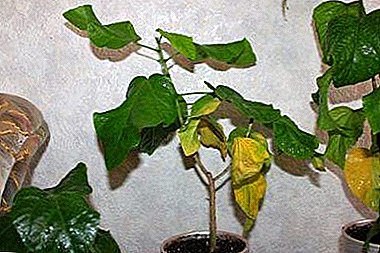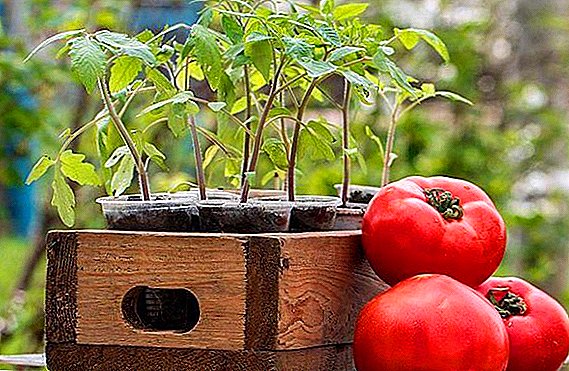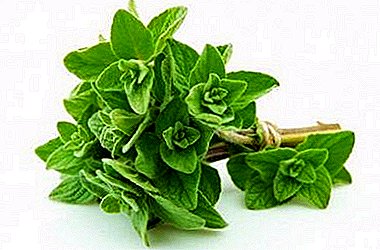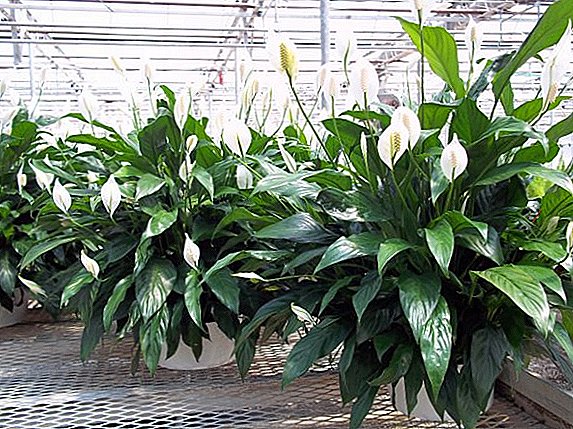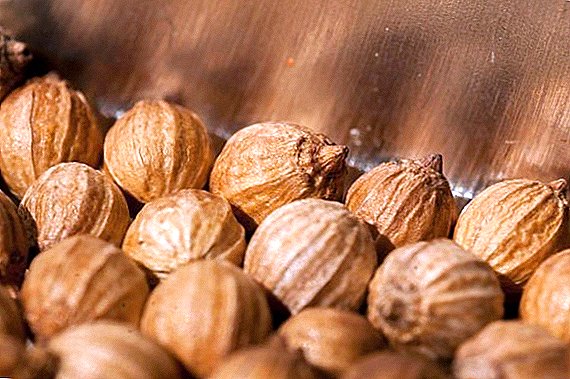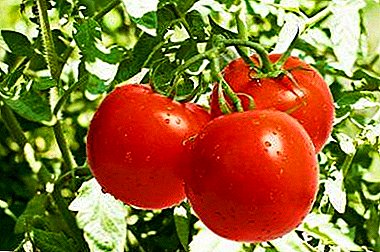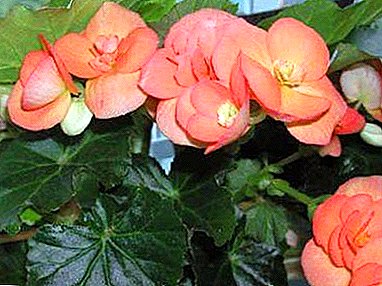
Contrary to popular belief, begonia is not only red flowers, which in spring are planted in flower beds in parks or gardeners plant their gardens. To date, more than 2,000 species of begonias have been bred, many of which are intended not for outdoor use, but for cultivation at home. Room begonia is popular among many gardeners for its unsurpassed beauty of flowers and amazing leaf shape. In this article we will tell you how to organize the care of begonia for indoor growing, what pests and diseases can threaten the flower and how to properly breed this plant.
Features of growing
In floriculture, there are two main subspecies of begonias.:
- decorative flowering;
- decorative leafy;
Based on the names, we can conclude that the first are appreciated for their bright colors, and the second - for their amazing leaves, which have an unusual shape and color.
Begonia flowers in shape most often resemble roses or camellias of a wide variety of colors.. With proper care, at home, the plant can bloom without interruption from late spring to late autumn (about why begonia does not bloom, and how to achieve beautiful buds, read here). Decorative leafy species bloom quite rarely, their flowers are faded, inconspicuous and, as a rule, do not give seeds. If you do not give such a begonia to bloom, it will significantly improve its well-being and prolong the life of the plant for several years.
Thin stems and delicate flowers of begonia make a deceptive impression that this plant is fragile, requiring painstaking care and careful care. In fact, everything is quite simple.
Most home-grown begonias come from the tropics (less often subtropics) and they need appropriate conditions:
- Bright ambient light. At the same time decorative and flowering species need more light, otherwise they can just stop blooming. Decorative leafy species quite comfortably exist far from the window.Important! Begonia does not like direct sunlight. If the plant is on the southern window-sill, it should be closed from the sun during the summer period.
- Comfortable temperature + 18-22 degrees. Begonia does not tolerate sudden changes in temperature. At +15 degrees the risk of hypothermia is high, if the temperature rises above +25, the flower may overheat.
 Abundant regular watering. During the flowering period, it is recommended to water the begonia at least 2 times a week; during the rest period, watering is reduced to the necessary minimum so that the earth does not completely dry out. Water for irrigation should be at room temperature, soft, without impurities.
Abundant regular watering. During the flowering period, it is recommended to water the begonia at least 2 times a week; during the rest period, watering is reduced to the necessary minimum so that the earth does not completely dry out. Water for irrigation should be at room temperature, soft, without impurities.- High humidity (not lower than 60%). The humidity of the air for begonias is even more important than the humidity of the soil; if the humidity is insufficient, the plant will dry out very soon. The best option is to use a humidifier.
Begonias are absolutely not recommended to spray, moisture on the leaves and stems can cause them to rot and a number of diseases, such as powdery mildew. In the absence of a humidifier, comfortable conditions for the plant can be created by placing the pot on a layer of wet expanded clay.
Breeding methods
The breeding of begonias occurs mainly vegetatively., as most ornamental varieties do not give seeds. For these purposes, use:
- cuttings;
- leaves;
- division of the bush.
Each individual species of begonias has its own breeding characteristics, which should be considered to achieve the desired result. In the case of leaf and stem cuttings, they can be germinated both in water and immediately in the soil, it is recommended to do it from late February to April - before flowering in the decorative-flowering species and before the beginning of the active growth period in the decorative-deciduous.
How to breed a plant by dividing a bush or a tuber is directly dependent on the structure of the plant, any breeding recommendations apply exclusively to specific begonia varieties.
We invite you to watch a video on the breeding of begonias by dividing the bush:
How to organize the cultivation of indoor flower?
 For begonias, it is important to immediately determine the place, this plant does not tolerate frequent changes and conditions. Eastern and south-eastern window sills are best suited for it, since it is on them that the level of illumination will most closely match what is necessary.
For begonias, it is important to immediately determine the place, this plant does not tolerate frequent changes and conditions. Eastern and south-eastern window sills are best suited for it, since it is on them that the level of illumination will most closely match what is necessary.
Also do not forget about feeding, this is especially true for decorative-flowering species, as flowering takes a lot of power from the plant. As soon as the begonia has blossomed, fertilization can be started (mineral complexes with potassium and phosphorus are ideally suited for flowering begonia species). As a rule, supplementation is carried out 2-3 times a month, but more detailed recommendations should be sought in the instructions for a specific preparation. Begonia should be fed up until the end of flowering.
For decorative and deciduous species are well suited mineral fertilizers with nitrogen. You need to make them from late spring to mid-autumn, when the plant begins a period of active growth.
When and how to transplant?
Replanting just bought a plant is not worth it, it will become additional stress and further weaken the plant. When the original pot becomes small begonias, and the roots begin to peek in the drainage holes and on the surface, it's time to change it to a more spacious one.
Reference! The best time for transplanting begonias is spring. During the flowering period, replanting the plant is strictly not recommended.
The first thing you should pay attention to when planning a transplant is the composition of the soil. Begonias prefer a slightly acidic soil, consisting of leafy soil, peat and black soil, such a composition can be bought ready-made in the store, and you can cook it yourself.
Transplant order:
- Prepare a new pot. It is recommended to choose a pot 5–8 cm larger than the previous one in diameter; it is this additional volume that will allow the plant to comfortably grow over the next 2 years before the next transplant.
Before planting, the pot can be treated with a solution of potassium permanganate or scalded with boiling water (this method may not be suitable for plastic pots). The adoption of these measures will ensure that there are no pathogens and will help protect the plant roots from diseases. - At the bottom of the pot poured a drainage layer, such as expanded clay. In order to protect the roots from excess moisture, a small amount of charcoal can be additionally added over the drainage layer.
- Drain from the top sprinkled with soil (2-3 cm, depending on the volume of the pot).
- Begonia is removed from the old pot, excess soil is carefully removed so as not to damage the roots.
- The plant is installed in the center of the pot and sprinkled with earth on all sides. Strongly tamper new soil is not necessary, begonias need air access to the roots.
- After transplantation, for some time the begonia is watered abundantly so that the soil does not dry out, if necessary, the top is filled with soil.
Even with intensive watering, you need to make sure that water does not accumulate in the pan, as this may lead to rotting of the roots.
We invite you to watch the video on transplantation of begonias:
Diseases and pests
There are a number of problems and diseases that are often encountered in begonias, and when faced with them, it is necessary to take timely measures to save the plant.
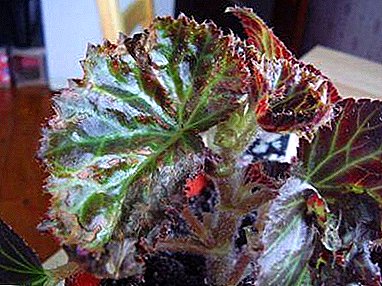 One of these problems is powdery mildew, which is expressed in the appearance of whitish spots and stripes on the lower sides of leaves and shoots. This disease occurs when there is an excess of moisture, as well as when water gets on the leaves and stems of begonia. The affected areas need to be removed, and the watering and humidification of the air should be reduced, this will help avoid the spread of the disease.
One of these problems is powdery mildew, which is expressed in the appearance of whitish spots and stripes on the lower sides of leaves and shoots. This disease occurs when there is an excess of moisture, as well as when water gets on the leaves and stems of begonia. The affected areas need to be removed, and the watering and humidification of the air should be reduced, this will help avoid the spread of the disease.- Also, excessive watering can lead to disease of the roots of gray and black rot. For obvious reasons, it is not always possible to immediately recognize this disease, but if the leaves darken, wither and fall - this is a sure sign that something is wrong with the root system.
- If black or gray rot is found, it is necessary to remove the plant from the pot and lower the roots for 2 hours in a solution of potassium permanganate, then remove all damaged areas and transplant the begonia into fresh soil.
- Of the parasites, begonia suffers most often from aphids, spider mites, and whitefly, and plentiful insecticide spraying saves them all.
- Yellowing and drying or wilting of the leaves may indicate hypothermia, insufficient air humidity or improper watering. In all these cases, the creation of the right conditions quickly bring the plant back to normal.
In addition to the above problems, begonias can also cause troubles such as twisting leaves and falling leaves and buds.
Both flowering and decorative leafy begonias can be an amazing addition to the home flower garden. It is surprisingly easy to grow and multiply them, and they can delight their owner almost all year round.


 Abundant regular watering. During the flowering period, it is recommended to water the begonia at least 2 times a week; during the rest period, watering is reduced to the necessary minimum so that the earth does not completely dry out. Water for irrigation should be at room temperature, soft, without impurities.
Abundant regular watering. During the flowering period, it is recommended to water the begonia at least 2 times a week; during the rest period, watering is reduced to the necessary minimum so that the earth does not completely dry out. Water for irrigation should be at room temperature, soft, without impurities. One of these problems is powdery mildew, which is expressed in the appearance of whitish spots and stripes on the lower sides of leaves and shoots. This disease occurs when there is an excess of moisture, as well as when water gets on the leaves and stems of begonia. The affected areas need to be removed, and the watering and humidification of the air should be reduced, this will help avoid the spread of the disease.
One of these problems is powdery mildew, which is expressed in the appearance of whitish spots and stripes on the lower sides of leaves and shoots. This disease occurs when there is an excess of moisture, as well as when water gets on the leaves and stems of begonia. The affected areas need to be removed, and the watering and humidification of the air should be reduced, this will help avoid the spread of the disease.
